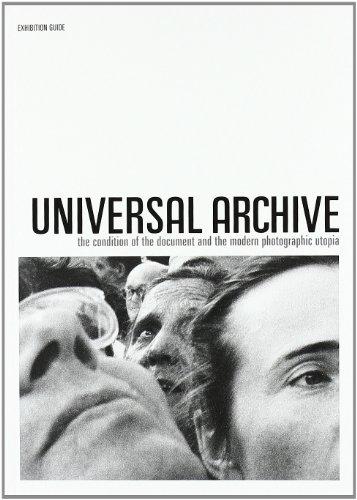Jorge Ribalta: Universal Archive: The Condition of the Document and the Modern Photographic Utopia (2008) [CA, ES, EN]
Filed under book, catalogue | Tags: · archive, barcelona, city, documentary photography, history of photography, photography

“This guide has been published on the occasion of the exhibition Universal Archive. The Condition of the Document and the Modern Photographic Utopia (2008-09) that analyses the idea of a document in the history of photography on the basis of the study and staging of a number of debates about the genre during the 20th century. With the aim of assessing various hypotheses about the meanings and mechanisms of the documentary, it traces a historical itinerary that gets under way with the beginning of the hegemony of photography in the illustrated press in the first third of the 20th century, before arriving at the purported crisis of photographic realism in the digital era at the end of the century. For all that, the exhibition is not a history of the genre, nor does it exhaust its possible definitions, but instead attempts to study how the photographic document has been constituted — in a consistently ambivalent and polemical way — in certain historical contexts. ”
Publisher Museu d’Art Contemporani de Barcelona (MACBA), Barcelona, 2008
ISBN 9788489771703
99 pages
via MACBA
Exhibition reviews: Max Andrews (Frieze 2009), David Evans (Photography & Culture 2010), Art Tattler (n.d.).
Arxiu universal (Catalan, 2008, PDFs)
Archivio universal (Spanish, 2008, PDFs)
Universal Archive (English, 2008, PDF, 3 MB)
Leshu Torchin: Creating the Witness: Documenting Genocide on Film, Video, and the Internet (2012)
Filed under book | Tags: · documentary film, documentary photography, film, genocide, holocaust, human rights, internet, mass media, photography, politics, television, video

“Since the beginning of the conflict in 2003, more than 300,000 lives have been lost in Darfur. Players of the video game Darfur Is Dying learn this sobering fact and more as they endeavor to ensure the survival of a virtual refugee camp. The video game not only puts players in the position of a struggling refugee, it shows them how they can take action in the real world.
Creating the Witness examines the role of film and the Internet in creating virtual witnesses to genocide over the past one hundred years. The book asks, how do visual media work to produce witnesses—audiences who are drawn into action? The argument is a detailed critique of the notion that there is a seamless trajectory from observing an atrocity to acting in order to intervene. According to Leshu Torchin, it is not enough to have a camera; images of genocide require an ideological framework to reinforce the messages the images are meant to convey. Torchin presents wide-ranging examples of witnessing and genocide, including the Armenian genocide, the Holocaust (engaging film as witness in the context of the Nuremburg trials), and the international human rights organization WITNESS and its sustained efforts to use video to publicize human rights advocacy and compel action.
From a historical and comparative approach, Torchin’s broad survey of media and the social practices around it investigates the development of popular understandings of genocide to achieve recognition and response—both political and judicial—ultimately calling on viewers to act on behalf of human rights.”
Publisher University of Minnesota Press, 2012
Visible Evidence series, Volume 26
ISBN 0816676224, 9780816676224
296 pages
Author’s discussion of the book
Publisher
PDF (updated on 2021-1-24)
Comments (3)Mary Strong, Laena Wilder (eds.): Viewpoints: Visual Anthropologists at Work (2009)
Filed under book | Tags: · anthropology, documentary photography, ethnoarchaeology, ethnographic film, ethnography, film, photography, video, visual anthropology

“Early in its history, anthropology was a visual as well as verbal discipline. But as time passed, visually oriented professionals became a minority among their colleagues, and most anthropologists used written words rather than audiovisual modes as their professional means of communication. Today, however, contemporary electronic and interactive media once more place visual anthropologists and anthropologically oriented artists within the mainstream. Digital media, small-sized and easy-to-use equipment, and the Internet, with its interactive and public forum websites, democratize roles once relegated to highly trained professionals alone. However, having access to a good set of tools does not guarantee accurate and reliable work. Visual anthropology involves much more than media alone.
This book presents visual anthropology as a work-in-progress, open to the myriad innovations that the new audiovisual communications technologies bring to the field. It is intended to aid in contextualizing, explaining, and humanizing the storehouse of visual knowledge that university students and general readers now encounter, and to help inform them about how these new media tools can be used for intellectually and socially beneficial purposes.
Concentrating on documentary photography and ethnographic film, as well as lesser-known areas of study and presentation including dance, painting, architecture, archaeology, and primate research, the book’s fifteen contributors feature populations living on all of the world’s continents as well as within the United States. The final chapter gives readers practical advice about how to use the most current digital and interactive technologies to present research findings.”
Text Editor: Mary Strong
Visual Editor: Laena Wilder
Publisher University of Texas Press, 2009
ISBN 0292706715, 9780292706712
384 pages
PDF (25 MB, updated on 2016-1-2)
Comments (2)
